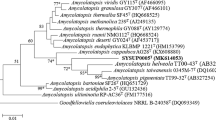Abstract
Polyphasic characterization of the echinocandin B producer Aspergillus nidulans var. roseus ATCC 58397 strain was carried out to elucidate its taxonomical status. According to its carbon source utilization and secondary metabolite spectrum as well as the partial β-tubulin, calmodulin, and γ-actin gene sequences, A. nidulans var. roseus belongs to the Emericella rugulosa species. Auxotroph mutants of A. nidulans var. roseus ATCC 58397 and E. rugulosa CBS 171.71 and CBS 133.60 formed stable heterokaryons on minimal medium with several A. nidulans strains, and in the case of A. nidulans var. roseus, even cleistothecia were developed.



Similar content being viewed by others
References
Barratt RW, Johnson GB, Ogata WN (1965) Wild-type and mutant stocks of Aspergillus nidulans. Genetics 52:233–246
Boeck LD, Kastner RE (1981) Method of producing the A-30912 antibiotics. US Patent 4:288–549
Bradshaw RE, Lee KU, Peberdy JF (1983) Aspects of genetic interaction in hybrids of Aspergillus nidulans and Aspergillus rugulosus obtained by protoplast fusion. J Gen Microbiol 129:3525–3533
Bruns TD (2001) ITS Reality. Inoculum 52:2–3
Carbone I, Kohn LM (1999) A method for designing primer sets for speciation studies in filamentous ascomycetes. Mycologia 91:553–556
Emri T, Zs M, Pusztahelyi T, Pócsi I (2004) Physiological and morphological changes in autolysing Aspergillus nidulans cultures. Folia Microbiol 49:277–284
Frisvad JC (1985) Secondary metabolites as an aid to Emericella classification. In: Samson RA, Pitt J (eds) Advances in Penicillium and Aspergillus systematics. Plenum, New York, pp 437–444
Frisvad JC, Larsen TO, de Vries R, Meijer M, Houbraken J, Cabañes FJ, Ehrlich K, Samson RA (2007) Secondary metabolite profiling, growth profiles and other tools for species recognition and important Aspergillus mycotoxins. Stud Mycol 59:31–37
Geiser DM, Klich MA, Frisvad JC, Peterson SW, Varga J, Samson RA (2007) The current status of species recognition and identification in Aspergillus. Stud Mycol 59:1–10
Glass NL, Donaldson GC (1995) Development of primer sets designed for use with the PCR to amplify conserved genes from filamentous ascomycetes. Appl Environ Microb 61:1323–1330
Hodges RL, Hodges DW, Goggans K, Xuei X, Skatrud P, McGilvray D (1994) Genetic modifications of an echinocandin B-producing strain of Aspergillus nidulans to produce mutants blocked in sterigmatocystin biosynthesis. J Ind Microbiol 13:372–381
Hong SB, Go SJ, Shin HD, Frisvad JC, Samson RA (2005) Polyphasic taxonomy of Aspergillus fumigatus and related species. Mycologia 97:1316–1329
Kevei F, Peberdy JF (1984) Further studies on protoplast fusion and interspecific hybridization within the Aspergillus nidulans group. J Gen Microbiol 130:2229–2236
Klich M, Mendoza C, Mullaney E, Keller N, Bennett JW (2001) A new sterigmatocystin-producing Emericella variant from agricultural desert soils. System Appl Microbiol 24:131–138
Pál K, van Diepeningen AD, Varga J, Hoekstra RF, Dyer PS, Debets AJM (2007) Sexual and vegetative compatibility genes in the aspergilli. Stud Mycol 59:19–30
Peterson SW (2008) Phylogenetic analysis of Aspergillus species using DNA sequences from four loci. Mycologia 100:205–226
Pontecorvo G, Roper JA, Chemmons LM, Macdonald KD, Bufton AWJ (1953) The genetics of Aspergillus. Adv Genet 5:141–238
Samson RA, Varga J (2009) What is a species in Aspergillus? Med Mycol 47(Suppl 1):S13–S20
Tamura K, Dudley J, Nei M, Kumar S (2007) MEGA4: Molecular Evolutionary Genetics Analysis (MEGA) software version 4.0. Mol Biol Evol 24:1596–1599
White TJ, Bruns T, Lee S, Taylor JW (1994) Amplification and direct sequencing of fungal ribosomal RNA genes for phylogenetics. In: Innis MA, Gelfand DH, Sninsky JJ, White TJ (eds) PCR protocols: a guide to methods and applications. Academic, New York, pp 315–322
Acknowledgements
M.M. is indebted for support from the Office for Subsidized Research Units of the Hungarian Academy of Sciences. This work was financially supported by the grant TAMOP-4.2.1/B-09/1/KONV-2010-0007. Authors are indebted to János Varga (University of Szeged, Szeged, Hungary) for his valuable help in the interpretation of DNA sequence data.
Author information
Authors and Affiliations
Corresponding author
Rights and permissions
About this article
Cite this article
Tóth, V., Nagy, C.T., Miskei, M. et al. Polyphasic characterization of “Aspergillus nidulans var. roseus” ATCC 58397. Folia Microbiol 56, 381–388 (2011). https://doi.org/10.1007/s12223-011-0059-4
Received:
Accepted:
Published:
Issue Date:
DOI: https://doi.org/10.1007/s12223-011-0059-4




